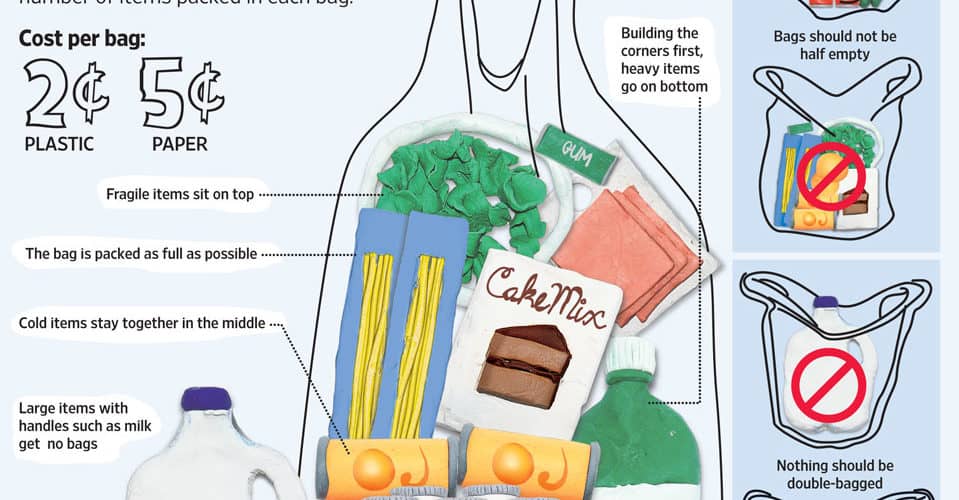It may seem like a no-brainer. But if you’ve ever arrived home from the market with broken eggs, smashed pies, or flea powder in the guacamole, you know why it’s so important to bag a grocery order properly. Do it right, and your groceries (and family) will thank you!
If you’re wondering how to bag groceries properly, here’s all you need to know.
Contents
STEP ONE: IDENTIFY THE CATEGORIES
The majority of grocery orders will break down into seven separate categories, and to avoid damaged goods and cross-contamination, they need to be kept separate. As the items come down the belt, evaluate the order and mentally break it down.
1. FRAGILE ITEMS: Be on the lookout for fragile items, such as eggs, salads, pies, and light bulbs. Anything easily damaged or breakable should be padded immediately and set aside to be bagged last.
2. MEATS and FISH: Always wrap each meat or fish item separately in its own individual plastic bag, and keep each type of meat or fish separate from the other types. Bag beef only with beef, and pork only with pork. Don’t bag the lamb chops with the hamburger, and keep uncooked shellfish separate from the other fish.
3. POULTRY: To prevent the potential spread of salmonella, every poultry item must ALWAYS be wrapped
individually and bagged separately from all other items in the order, including other poultry items.
4. FRUITS and VEGETABLES: All fruit and vegetable items which are not already wrapped should be placed in their own separate plastic bags as well. Always bag all produce apart from the rest of the order.
5. FOODS REQUIRING REFRIGERATION: Frozen foods and products which require refrigeration (such as milk, butter, eggs, and yogurt) should always be bagged together, and apart from other items. It’s okay to mix items within this category. Note that things like eggs and yogurt are easily damaged, and therefore fall into the “fragile” category as well!
6. CLEANING PRODUCTS and OTHER CHEMICAL ITEMS: For obvious reasons, all chemical items, such as
cleaning products, scented candles, bug spray and the like, must ALWAYS be bagged apart from all other items, regardless of how securely they appear to be packaged. No exceptions!
7. CANNED and PACKAGED GOODS, PAPER ITEMS, and HOUSEWARES: Canned and packaged goods need no
special handling in and of themselves, but should generally be bagged apart from items in the other categories.
STEP TWO: THE PROPER WAY TO PACK A GROCERY BAG
Once you’ve got your categories straightened out, all items still need to be placed correctly in their bags. A well-packed grocery bag will ideally be able to stand on its own, so it needs to wind up with as much shape and form as possible. This is especially important if the bag is made of plastic.
THINK LIKE AN ARCHITECT: In order to bag groceries properly, think of yourself as an architect. What you’re trying to do is build a little room, with walls and a floor. The “walls” should be built with solid, boxy-shaped items, while the heaviest items should always be used to build the “floor.”
For instance, for a bag of “cold” items, line the “walls” with boxes of frozen dinners, and the “floor” with heavier, squarish products, such as ice cream. You can then fill the middle section of the bag with the smaller, more fragile items, such as yogurt or frozen vegetables.
REMEMBER THESE IMPORTANT POINTS
1. When loading any grocery bag, the heavy items must always go on the bottom, and the lighter, fragile items must always go on the top. Don’t place a five-pound sack of potatoes on top of a carton of eggs!
2. Anything that can be crushed, such as bread, cakes, pies, etc., should always go into its OWN bag.
3. Never, under any circumstances, place a chemical product in the same bag with edible items.
4. Remember the risk of salmonella, and always bag poultry products separately.
5. Don’t overload any one bag! Try to distribute heavy items among several bags, and pack that gallon of milk or six-pack of sparkling water all on its own.
BE A BAGGING SUPERSTAR
A properly-bagged grocery order is a thing of beauty. Follow the rules above, and you can pack a bag to be proud of.



